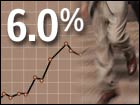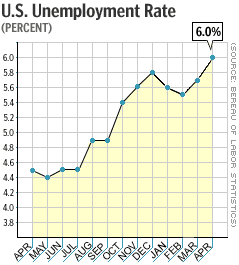
NEW YORK (CNN/Money) -
The U.S. unemployment rate jumped to 6 percent in April, the highest in nearly eight years, the government said Friday, as the labor market struggled to recover from a recession that led to more than a million job cuts in 2001.
Though the number took many economists by surprise, they also urged that it was no cause for alarm, since unemployment is a lagging indicator that typically rises even as the economy recovers, as employers are unwilling to hire workers until they're convinced of the recovery.
The unemployment rate was 5.7 percent in March. Employers added 43,000 jobs to payrolls in April, compared with a revised loss of 21,000 jobs in March, the Labor Department reported. Economists surveyed by Briefing.com had forecast an unemployment rate of 5.8 percent and 60,000 new jobs.
"Folks are coming back into the labor market, but they're not finding jobs there," Jared Bernstein, labor economist at the Economic Policy Institute, told CNNfn's Before Hours program. "The tepid pace of job growth was too low to keep unemployment from rising. We're looking at a fairly weak recovery, at least initially."
But many economists doubt the rising unemployment is a sign that the recovery from a recession that likely began in March 2001 will disappear or turn into a "double dip" recession. And, while unemployment is likely to rise again this year, few economists think it will greatly exceed 6 percent.

Nevertheless, on Wall Street, stocks fell after the report as investors worried about the strength of the recovery. Treasury bond prices were mixed.
The unemployment rate was the highest since a like 6 percent in August 1994. Since the rate bottomed out at 3.9 percent in October 2000, the number of people out of work has risen by 3.1 million, the Labor Department said.
To put things in perspective, however, April's unemployment rate is still significantly lower than the peaks that followed the two previous recessions -- 10.8 percent in 1983 and 7.8 percent in 1992.
One reason for April's jump in unemployment is an abrupt gain in the size of the civilian labor force, the total number of workers either employed or unemployed and looking for work. That number grew by 565,000 in April after shrinking by 206,000 in March.
"Rising unemployment, ironically, contains good news," said Bill Cheney, chief economist at John Hancock Financial Services. "It signals people who had given up and dropped out of the work force are back looking for jobs. Clearly, they have hope there are jobs to be found."
While it seems inconsistent that the unemployment rate could rise even as the economy added jobs, the two numbers are actually generated by separate surveys -- the unemployment rate comes from a survey of households, while the payrolls data come from a survey of businesses.
Also, the payrolls data are subject to dramatic revision. For example, the government's initial reading of growth outside the farm sector in March found 58,000 new jobs, but the number was later revised to a loss.
Many economists think at least 100,000 jobs need to be added every month to have enough of an impact on the household survey to keep the unemployment rate from rising.
Another silver lining - Fed to sit tight
To keep consumers spending despite rising unemployment and a recession that likely began in March 2001, the Federal Reserve cut its target for short-term interest rates 11 times in 2001.
Fed policy makers are scheduled to meet Tuesday to again discuss interest rates. The central bank has left rates alone so far in 2002, and many economists think it will continue to do so until the unemployment rate stops rising, particularly since inflation seems to be a distant threat.
"The path of the unemployment rate is the key to the timing of the Fed's initial tightening move," said Merrill Lynch chief economist Bruce Steinberg. "In our view, the Fed won't tighten until August at the soonest."
In its report, the Labor Department said the service sector, by far the nation's largest employer, added 134,000 jobs in April, while the manufacturing sector lost 19,000 jobs. During the height of an 18-month manufacturing recession, monthly job losses between January 2001 and January 2002 averaged 111,000 a month.
| |
 Related links
Related links
| |
| | |
| | |
|
The average work week for all industries fell to 34.1 hours from 34.2 hours in March. Economists surveyed by Briefing.com expected an unchanged work week. The length of the manufacturing work week was unchanged at 41 hours, while overtime manufacturing hours rose to 4.3 from 4.2.
Average hourly earnings rose by 2 cents in March to $14.69, a gain of just 0.1 percent. Economists surveyed by Briefing.com expected a gain of 0.3 percent.
With companies increasing output without greatly increasing wages, corporate productivity and profits likely will benefit, possibly helping to fuel business spending later in the year. Greenspan and other economists think business spending will be key to the broader economic recovery; after all, a slowdown in corporate spending brought on the recession in the first place.
Temporary payrolls also rose, another hopeful sign for future employment, as businesses usually hire temps as the first tentative step towards hiring more permanent workers.
"More and more firms are sticking their toes in the water," said Anthony Chan, chief economist at Banc One Investment Advisors. "The recovery's begun, but it will be fragile."

|

